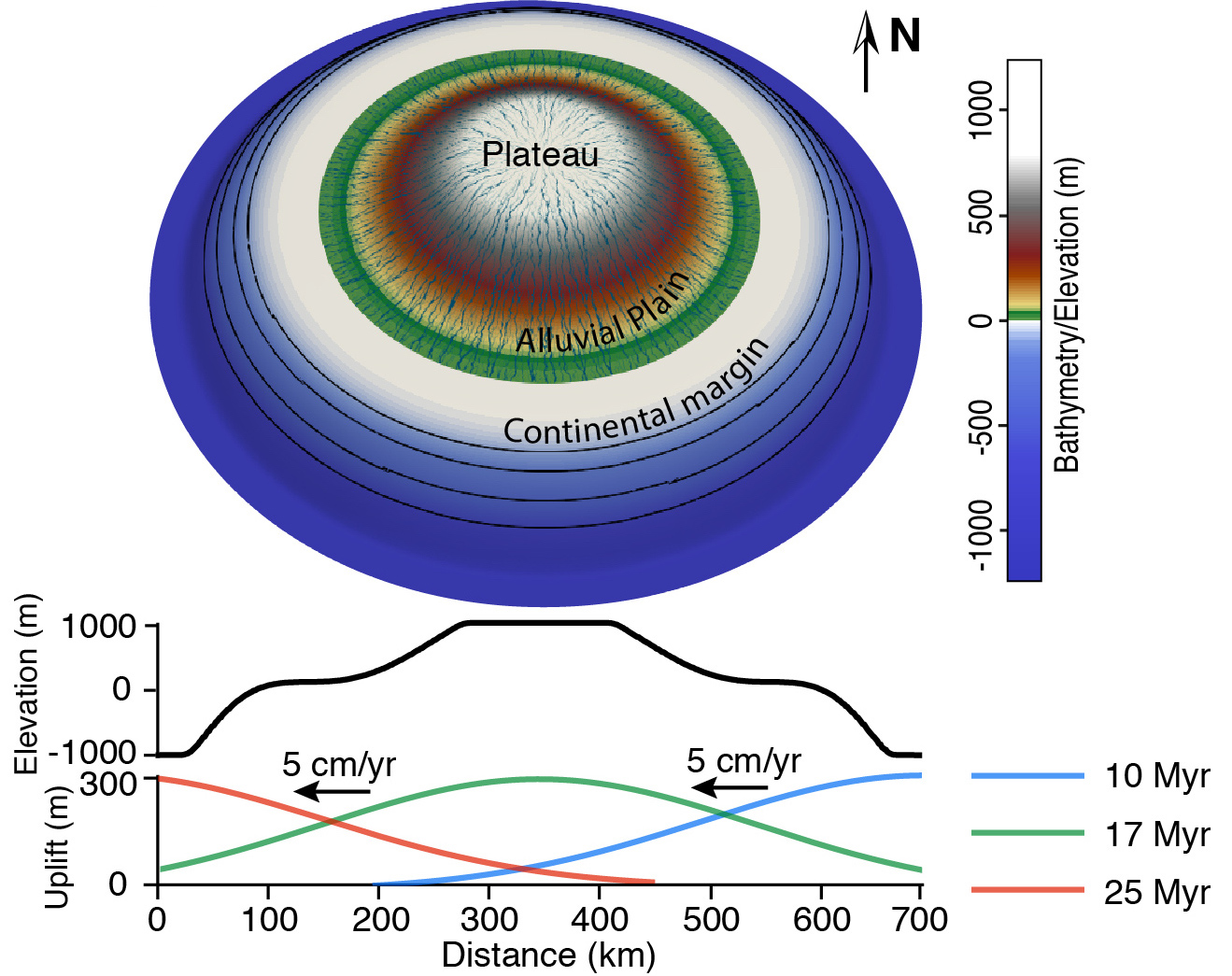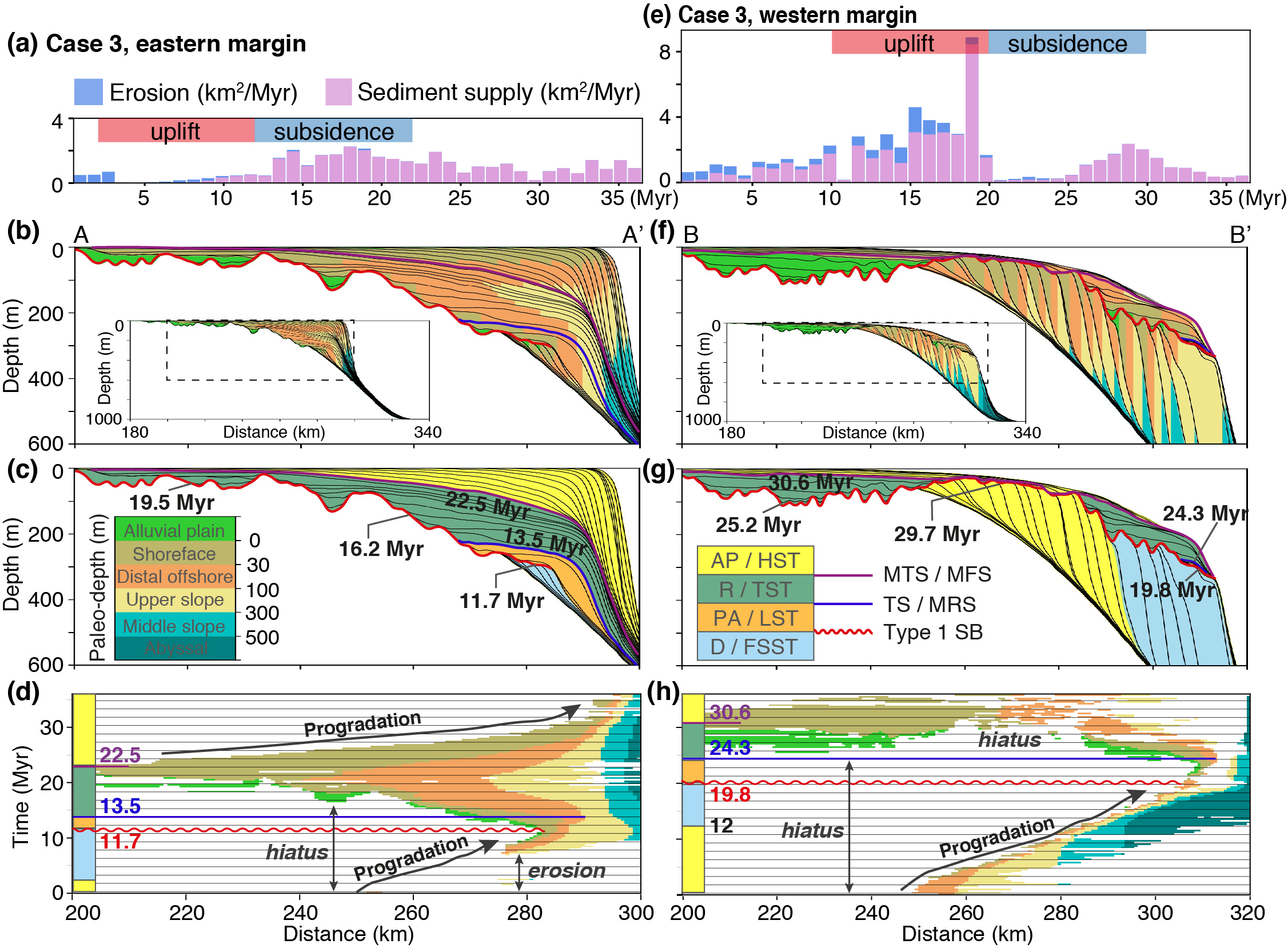Dynamic topography and sediment routing systems
Xuesong Ding, Tristan Salles, Nicolas Flament, Claire Mallard, Patrice Rey
Software Used:
- Badlands 1.0
Model Setup:
 Model setup of a generic case showing a wave of positive dynamic topography migrating under a fixed circular continent. The circular continent is 700 km in diameter with a spatial resolution of 1 km. Its initial landscape of the continent consists of a central plateau (source area) surrounded by an alluvial plain (transfer zone) and a continental margin (sink area). A sinusoidal wave of positive dynamic topography with a wavelength of 1000 km and amplitude of 300 m propagating to the west at 5 cm/yr is considered.
Model setup of a generic case showing a wave of positive dynamic topography migrating under a fixed circular continent. The circular continent is 700 km in diameter with a spatial resolution of 1 km. Its initial landscape of the continent consists of a central plateau (source area) surrounded by an alluvial plain (transfer zone) and a continental margin (sink area). A sinusoidal wave of positive dynamic topography with a wavelength of 1000 km and amplitude of 300 m propagating to the west at 5 cm/yr is considered.
Conditions:
| Variables | Parameter | value |
|---|---|---|
| Non Marine Erodibility | K_e | 2.e-7 |
| Rainfall | P [m/a] | 1.0 |
| (Rainfall * Area) exponent m | m | 0.5 |
| Slope exponent n | n | 1.0 |
| Slope Minimum for Flood-plain Deposition | slp_cr | 0.001 |
| Non-Marine % Max Deposition | perc_dep | 0.5 |
| Land sed. Transport by River | criver | 10 |
| Land sed. Transport by Wind | caerial | 0.001 |
| Lake/Sea sed. Transport by Currents | cmarine | 0.005 |
| No. Time Steps To Distribute Marine Deposits | diffnb | 5 |
| Marine % Max Deposition | diffprop | 0.4 |
Results:
 (a) Sediment supply histories and erosion of stratigraphic layers, stratal stacking patterns represented by (b) depositional environments, (c) interpreted systems tracts, and (d) Wheeler diagrams reconstructed on the eastern margin. (e-h) Same for the western margin. Paleo-depth is assumed to be a proxy for depositional environments, including alluvial plain (>0 m), shoreface (or delta front, 0-30 m), distal offshore (or prodelta, 30-100 m), upper slope (100-300 m), middle slope (300-500m) and abyss (>500 m). Key stratigraphic surfaces and their timing are indicated in c, d, g and h. Systems tracts are interpreted for Case 3 with abbreviations: A - aggradation, P - progradation, R - retrogradation, D - degradation, HST - highstand systems tract, TST - transgressive systems tract, LST - lowstand systems tract, FSST - falling-stage systems tract, MTS - maximum transgressive surface, MFS - maximum flooding surface, TS – transgressive surface, MRS - maximum regressive surface, SB - sequence boundary.
(a) Sediment supply histories and erosion of stratigraphic layers, stratal stacking patterns represented by (b) depositional environments, (c) interpreted systems tracts, and (d) Wheeler diagrams reconstructed on the eastern margin. (e-h) Same for the western margin. Paleo-depth is assumed to be a proxy for depositional environments, including alluvial plain (>0 m), shoreface (or delta front, 0-30 m), distal offshore (or prodelta, 30-100 m), upper slope (100-300 m), middle slope (300-500m) and abyss (>500 m). Key stratigraphic surfaces and their timing are indicated in c, d, g and h. Systems tracts are interpreted for Case 3 with abbreviations: A - aggradation, P - progradation, R - retrogradation, D - degradation, HST - highstand systems tract, TST - transgressive systems tract, LST - lowstand systems tract, FSST - falling-stage systems tract, MTS - maximum transgressive surface, MFS - maximum flooding surface, TS – transgressive surface, MRS - maximum regressive surface, SB - sequence boundary.